Takashi Murakami: Japanese kawaii exhibit at Vancouver Art Gallery! Hello Kitty Taipei airport lounge & gift shop.
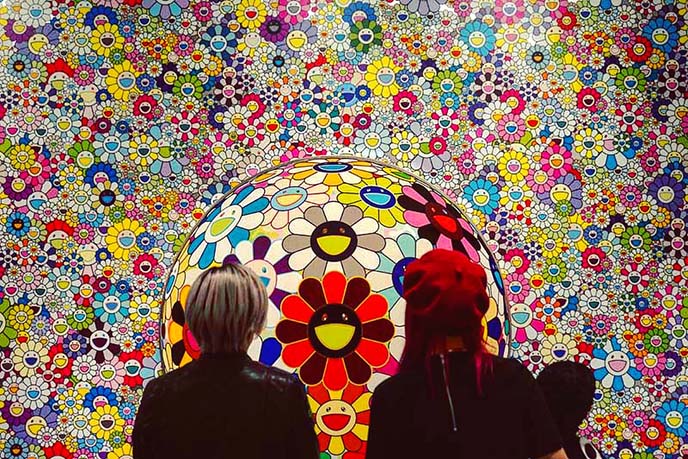
When one of your favorite Japanese artists is in town… It’s time to get trippy!
If you love manga, anime and “kawaii” Japanese pop culture, then head down the rabbit hole to Takashi Murakami’s exhibit at Vancouver Art Gallery.
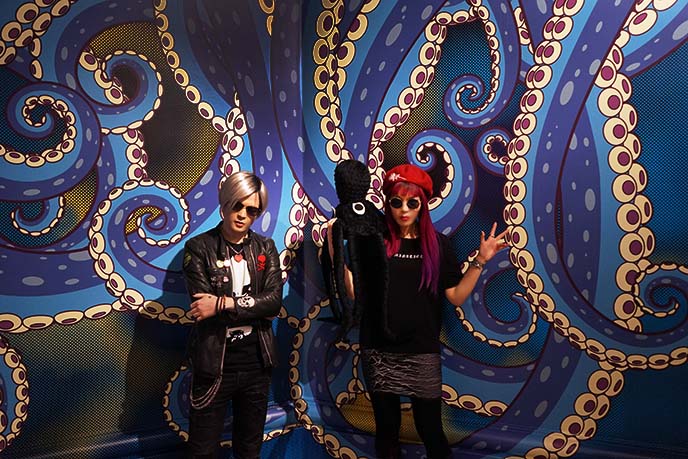
For the first time, Murakami’s major works have come to Canada. Over 50 pieces spanning three decades are currently on display at VAG (from Feb 2 to May 6, 2018).
The retrospective is titled “The Octopus Eats Its Own Leg,” so get ready to dive into a world of tentacles.

Read on to the end of this story, where I’ll also share photos of the Hello Kitty airport lounge in Taipei (since we’re on the topic of Japanese pop-cute). It’s definitely the world’s weirdest airline lounge, featuring Sanrio characters!
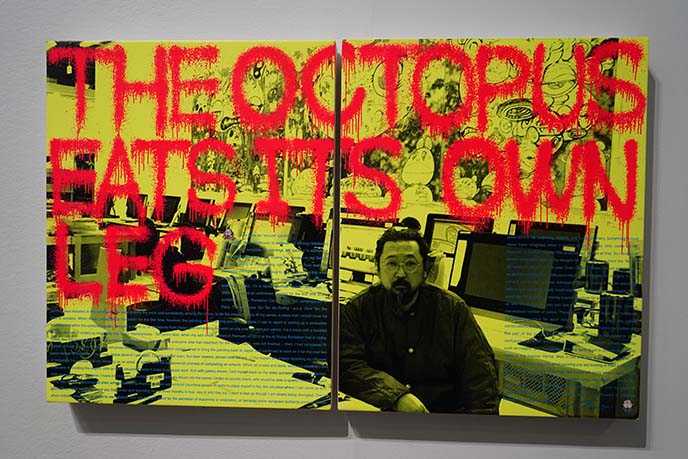
Murakami Takashi (村上 隆) is one of Japan’s most intriguing contemporary artists. You might recognize his smiling flowers and cartoon bears, which were on the cover of a Kanye West album and Louis Vuitton purses.
However, as I found out from this exhibit, Murakami’s artistic tentacles reach far deeper than pop commentary on consumer culture. The exhibition’s title, “The Octopus Eats Its Own Leg,” refers to a Japanese parable where the creature survives by sacrificing parts of himself. In this way, “Takashipom” consumes his native history and spirituality, transforming them into colorful new visions.

The Vancouver Art Gallery went all-out to welcome Murakami. Each window is plastered with happy flower decals, and the rotunda looks like it’s been attacked by a pink and blue cephalopod, Godzilla-style. The artist himself came here for the opening, dressed in a tentacles-hat for the occasion.
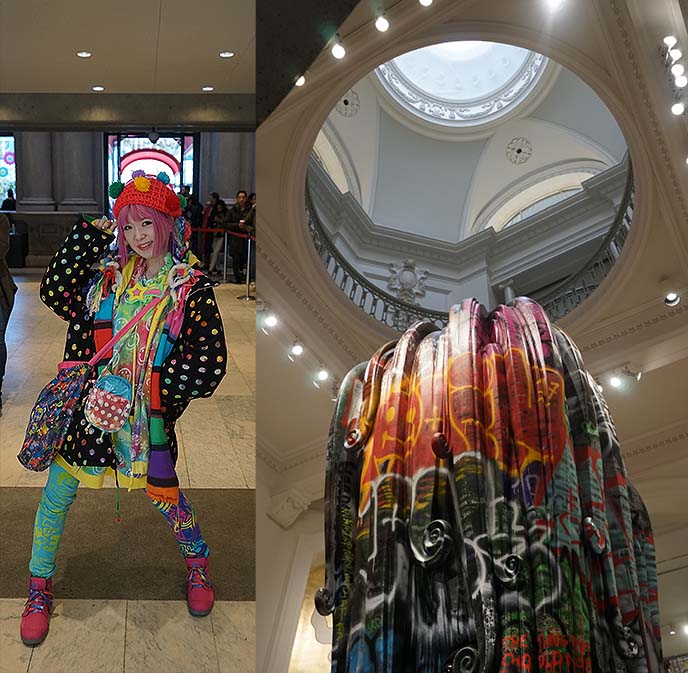
The Murakami exhibition is already an immense success, drawing in queues of visitors. Instead of spending time in line, I recommend that you purchase a ticket in advance from the Vancouver Art Gallery website (it lets you choose the specific date of your visit.) You may also want to aim for a weekday visit, since the space was packed over the weekend.
The Japanese artist is known for his eccentric outfits. I was pleased to see that a few visitors dressed up for the occasion; I loved this girl’s Harajuku decora candy style.

During the grey winter months, it’s a joy to wander among giant neon paintings with friends.
Murakami’s best-known works are influenced by Japanese “kawaii’ (big-eyed, round cuteness), with nods to anime, manga and otaku culture. However, these critters always have a deadly or bizarre twist
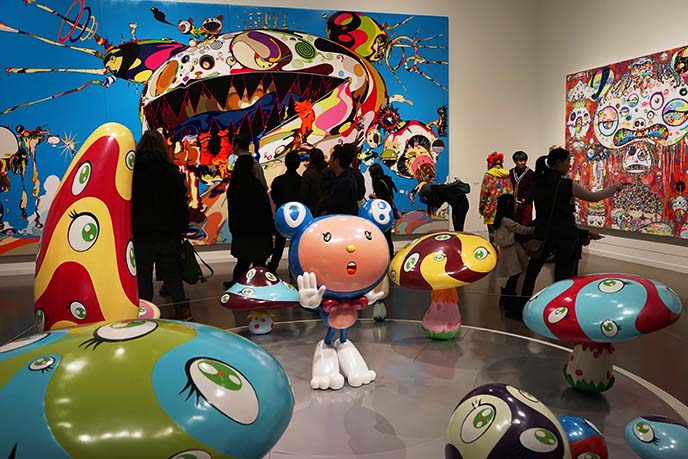
The exhibition spans several huge rooms, and includes wall-sized works and ceiling-high sculptures. Many feature Mr. Dob, his cute character who is a bit like Hello Kitty meets Mickey Mouse.
In his 3D work “DOB in The Strange Forest,” Murakami surrounds the innocent mouse-bear with seeing-eyed mushrooms. In the back, he’s become an unhinged monster spewing vomit (the painting is called “Tan Tan Bo Puking.”)
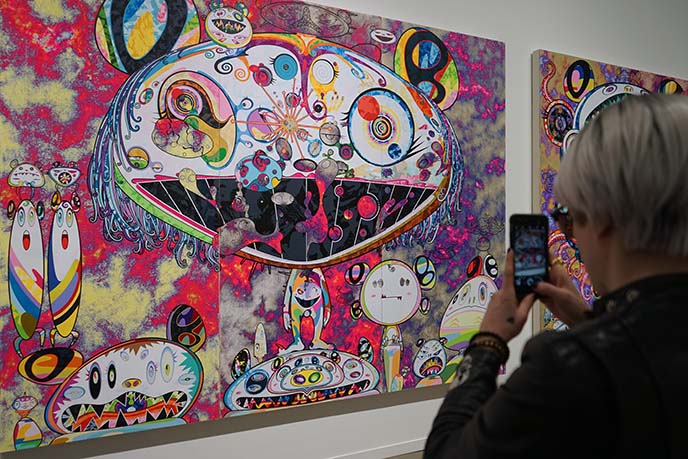
The mutant Mr. Dob reflects on how icons can run amok, hiding sharp fang beneath inviting surfaces. Despite this commentary on consumerism, Mr. Dob has (ironically? purposefully?) become a popular design on Louis Vuitton bags and other branded designer goods.
(Click the images below to see Murakami’s art x commerce collaborations):
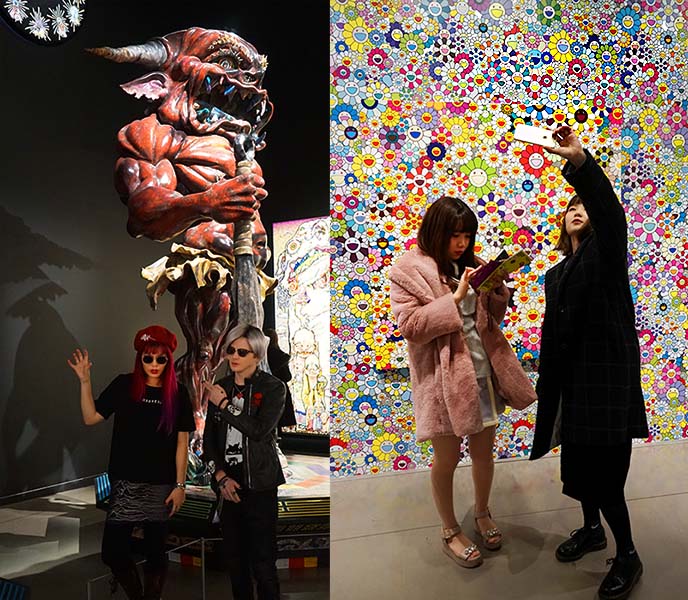
Anyone can take photos inside the exhibition, which makes it highly Instagrammable. One of the most popular selfie-spots is in front of this happy floral wall. Murakami once described these flowers as making him “feel almost physically sick, and at the same time I found them very cute.”

We’re mesmerized by “Flower Ball.” As Ben mused, “Where does art end, and wallpaper begin?”

Murakami is best known for his “Superflat” high-meets-low, 2D pop imagery. However, he explores many other facets of Japanese culture in other works, often with a darker vibe.

One of the most powerful rooms held towering red and blue demon totems (Embodiment of “A” and Embodiment of “Um”). These statues imagine a present-day belief system, built on ancient myths and folklore.

Murakami was devastated by the 2011 Japan earthquake and tsunami. The tragedy inspired a new direction in his art: he drew upon Japan’s cultural heritage to create spiritual narratives.
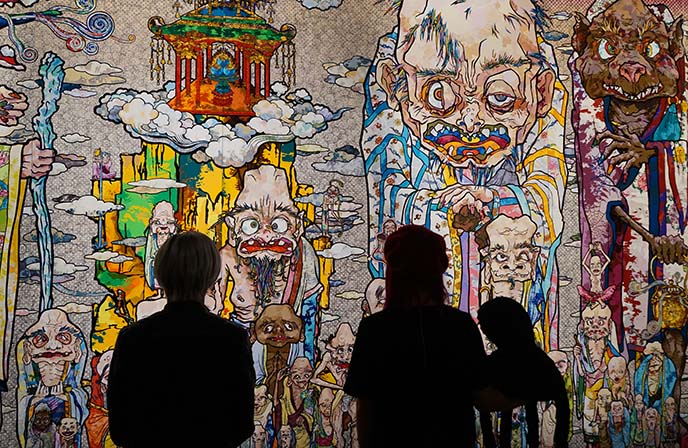
One of these masterpieces from this era is on display: a 10-panel painting called “The 100 Arhats.” It was painstakingly made by layering hundreds of silk screens, and depicts Buddhist monks who roamed Japan and helped enlighten people.

Many of Murakami’s works are inspired by “Nihonga,” the late 19th century fusion of Western and Japanese artistic techniques. In the above work, “Of Chinese Lions, Peonies, Skulls and Fountains”, he illustrates the legend of the lion who guards Buddhist temples. The cute baby cub and rainbow stream of skulls made it one of my favorites.
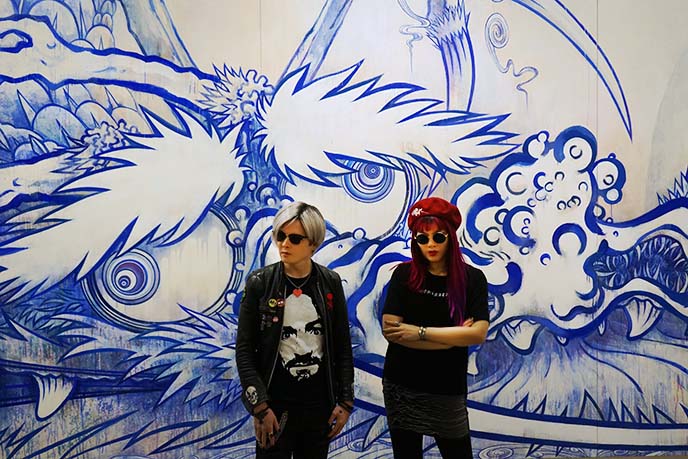
Murakami’s works are big, in terms of both size and concept. This is “Dragon in Clouds – Indigo Blue”, a re-imagining of a 1763 Japanese fantasy painting by Soga Shohaku.

Takashi Murakami is often compared to Andy Warhol. The Japanese artist is better received outside of his homeland, where some deride him for being too commercial/marketing oriented. Personally, I think these detractors are only skimming the surface; both artists made provocative works that went far deeper than soup cans and smiley flowers.
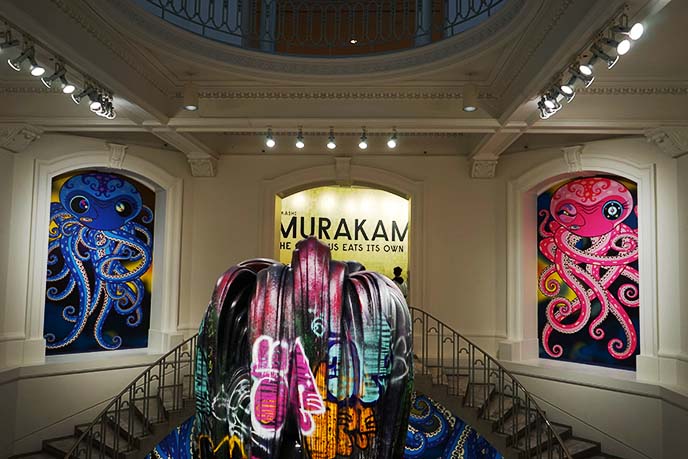
Intrigued? I encourage you to come out to Vancouver Art Gallery to see Murakami’s works in person. There’s no other way to get a full sense of his scale and impact.
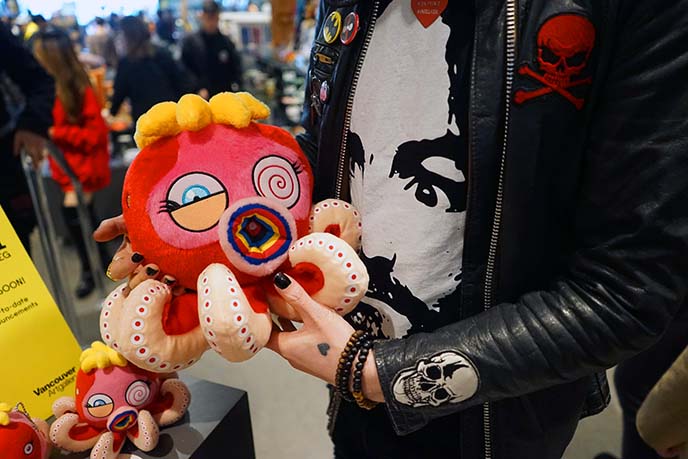
Exit through the gift store... There’s a selection of pins, toys, prints and more. This bizarro octopus plush caught our eye. Looks like something that Charles Manson might embrace.
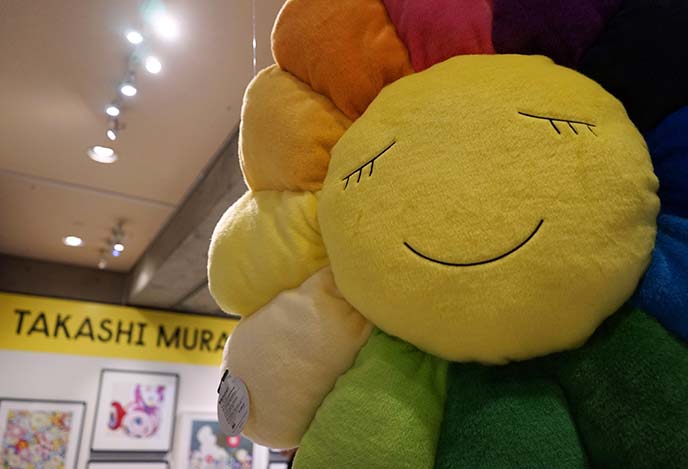
Have you heard of Takashi Murakami? Are you also a fan of his work? (You can browse his fashion designs below:)

A final close-up of Murakami’s flowers (note the tiny faces), and my outfit of the day. My red 90s beret and Domination top are by Mary Wyatt London. My round minimalist sunglasses are Edwardson Eyewear.

I’m also loving my new Bulgari Serpenti metallic leather bracelet, which matches my snake plant! I only wear jewelry with edge; the ring is Alex Streeter. (More Blvgari bracelets below):

Since we’re on the subject of “kawaii” culture… I thought I’d end with photos I took during a stopover, at Taipei’s Taoyuan Airport. If you go to Terminal 2, gate C3… you’ll discover a Hello Kitty airport lounge!
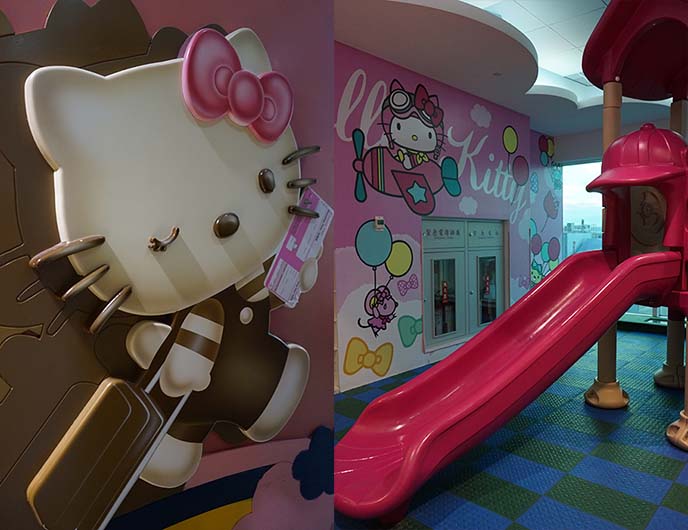
Although Hello Kitty is from Japan, the mouth-less cat is popular all over Asia. Taiwan loves her so much that they have an airport lounge in her name. The large waiting area has plenty of seats, a kid’s play area, and a nursing station featuring images of baby Kitty and Daniel.
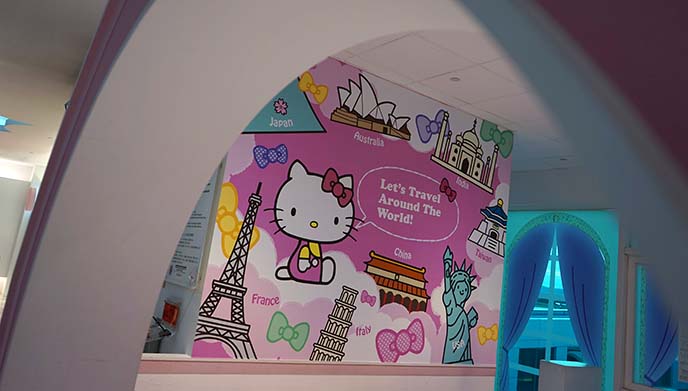
Taiwan’s Eva Air even launched a Hello Kitty jet, which mainly flies routes to Japan. Everything about the flight is in her likeness: the tickets, staff outfits, food, and art on the side of the airplane. (The Hello Kitty plane was so popular that EVA Airlines now also has Pokemon and Gudetama themed flights.)

In Taipei’s airport lounge, Hello Kitty is depicted as a world traveller. We see her wearing pilot goggles, and toting a suitcase behind her with a wink. The murals show the cat flying on her pink airplane to Sydney, India, New York, Rome and Paris.

These pictures are pretty accurate if you think of it… Since Sanrio launched her in 1974, Hello Kitty has taken over the world. I see merchandise with her face on it everywhere I travel.

I filmed an Instagram video here that shows you more of the pink, ridiculous terminal. Is this Hello Kitty heaven… or hell? That’s all up to you.
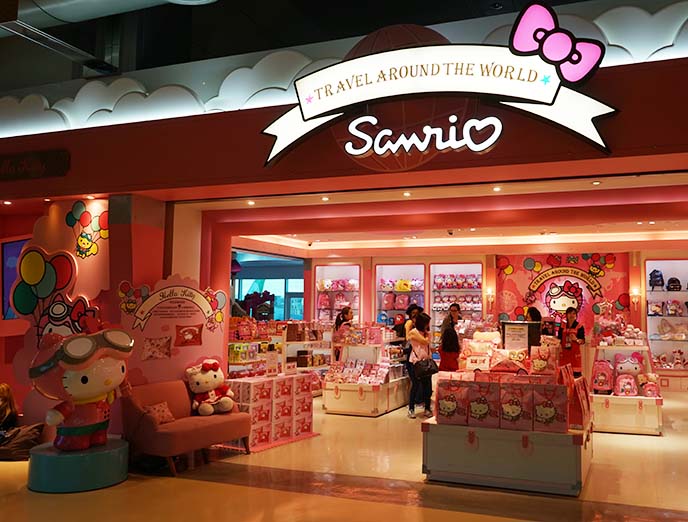
Right next door is the ultimate gift store, aptly named Hello Kitty Dream World. Taiwan Taoyuan airport has a few Sanrio shops, and they’re open from early morning to late evening.

“I like to stop at the duty free shop!” Especially when it’s filled with rare Hello Kitty and Sanrio character goods. I was tempted to get stationery, stuffed toys, jewelry, backpacks, kitchen items…

Hello Kitty isn’t just for children. Sanrio has released multiple designer fashion and jewelry collaborations. I’m eyeing this Hello Kitty sequin dress, cashmere sweater and more below…

Over the years, Sanrio has added more adorable animals to the family. Above is Bad Badtz Maru, Pompompurin, Cinnamon Roll and My Melody.

Some of the character items are on the weird side. I need a Hello Kitty robot cleaner in my life…

If you’re planning a trip to Taipei or doing a layover, look out for the Hello Kitty lounge in Taoyuan Airport (Terminal 2, section C3).

I grew up with Hello Kitty, so I’ll always have a soft spot for her. How about you?
And what do you think of Takashi Murakami’s mind-bending exhibit?
SHARE & COMMENT
How to spend a 24 hour stopover in Panama City! Sortis Hotel & Manabi restaurant, Casco Viejo historic district.

Say yes to travel. Always!
When I realized I could do a free 24-hour stopover in Panama City, I immediately chose that flight. Even though I only had a brief time in Panama’s capital, I got a nice taste of the culture, food, architecture… and it’s something I’ll never regret.

I had to fly through Panama, on my route between Dominican Republic and Cuba. I realized I could book a flight with a long connection time / stop-over, which allowed at least 24 hours to get out and explore. It didn’t cost extra, and it was a better option than hanging around the airport for over 6 hours… so why not?
If you can choose to do a 24 hour layover in Panama City, you should go for it. The timing was enough for me to get the lay of the land, see some sights (like Casco Viejo and the waterfront), and enjoy Panamanian food. Read on to see how I spent a day in the city of the Canal…

But first, a quick announcement. I’m back in San Francisco in early March with friends! We’ll be hitting up the synthwave party Turbo Drive (with a performance by retrowave artist Danger), as well as the infamous Goth night Death Guild. If you’re in SF, come out and dance with us.
(Above, wearing jewelry by my favorite Alex Streeter: Mars Star stud earrings, and Ouroboros creatures ring.)

And now, back to my Central American stopover story.
Some cities are better for layovers than others. Panama City turned out to be a great one — because Tocumen International Airport is only a 30 minute drive from downtown Panama City.

If you have limited time in a destination, I recommend booking a hotel that is centrally located. I stayed at Sortis Hotel, Casino and Spa since it was right in the bank district, and near the waterfront and famous sites. The staff arranged private car to pick me up from airport Arrivals, which helped me to save time and keep my trip as seamless as possible.
Sortis Hotel address: Calle 56 y 57 Este, Panamá, Panama
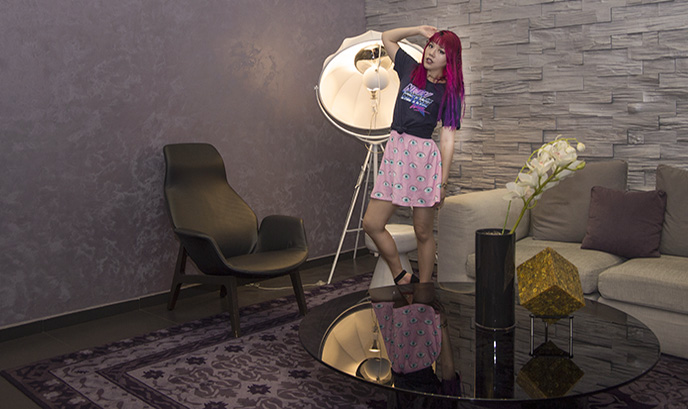
Sortis Hotel’s hip decor matched my pastel-Gothic vibe. They’re part of the boutique design hotels collective, Autograph Collection, meaning you can expect luxurious, modern accommodations and service.

I arrived in the evening, so I was glad to spend time under the waterfall shower and then curl up for bed. Sortis’ rooms are large and decorated in urban chic, with giant windows that let you wake up to the famous skyscrapers of Panama.
Outfit details: My velvet shoes are Le Babe, my t-shirt is Akade Wear by New Retro Wave, and my skirt is Print All Over Me by Coucou Suzette.
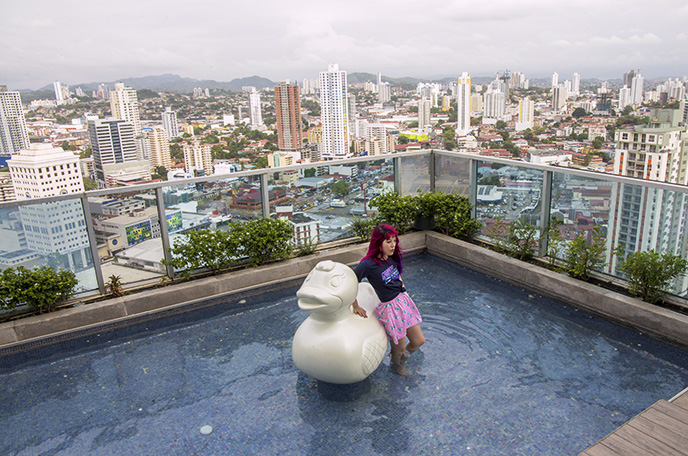
The next day, I woke up early for the included breakfast buffet, and so that I could have as much time as possible to see Panama City before my flight in the early evening.
I got a wonderful introduction to Panama City on the rooftop of Sortis Hotel. They have a panoramic terrace, and a swimming pool with a cute white duck in it!
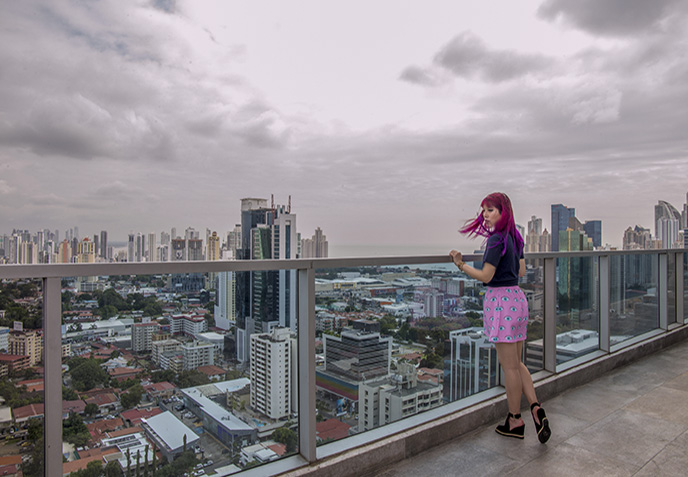
I looked out at the iconic cityscape, marked with tall silver towers. Instantly loved the vibrant and energetic environment of Ciudad de Panamá.
Perhaps you might be surprised to see so many skyscrapers here. Beginning in the early 2000s, Panama City had a construction boom that resulted in dozens of futuristic high-rises.

Panama City has become a major financial, tech and business center –– but it still has that laid-back, warm Central American vibe. Sortis’ inviting swimming pool, with towers and palm trees in the background, captures this mix perfectly.
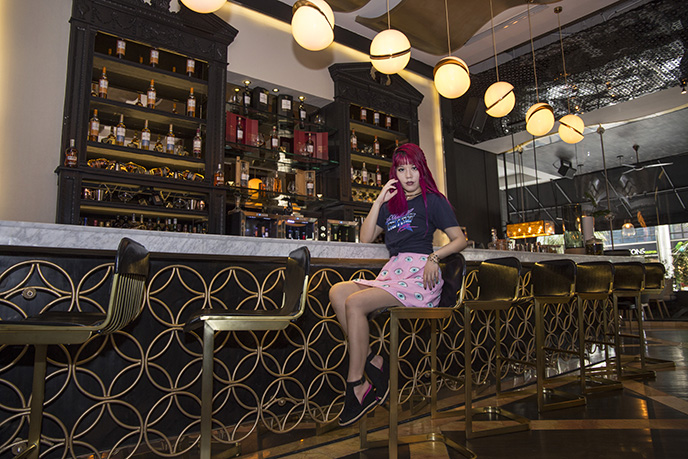
Unlike other parts of Central America, there’s also a high-end element to Panama City. I’m hanging in the lobby’s Veuve Cliquot champagne lounge. Sortis Hotel also adjoins a shopping center, and is near the new Soho Mall for luxury designer brands.
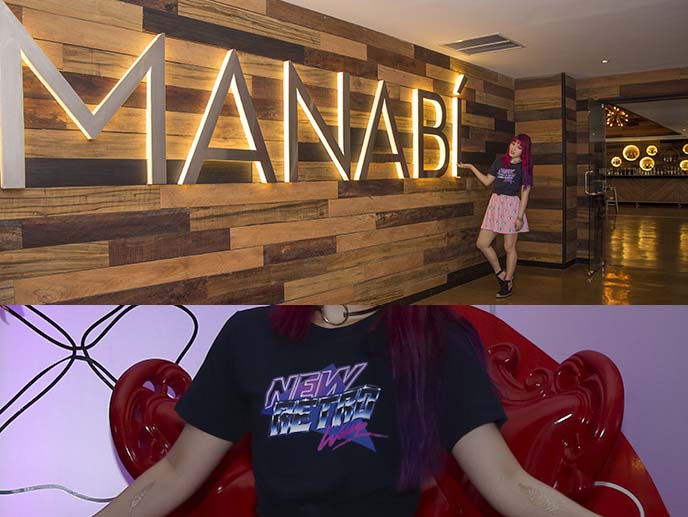
If you only have a twenty-four hour stopover, be sure to take the time to try the local cuisine. On my first night, I ate dinner at Manabi Restaurant and Rum Lounge, which specializes in Panamanian dishes.
(My New Retro Wave shirt is Akade Wear, designers of synthwave / outrun / retrowave fashion.)
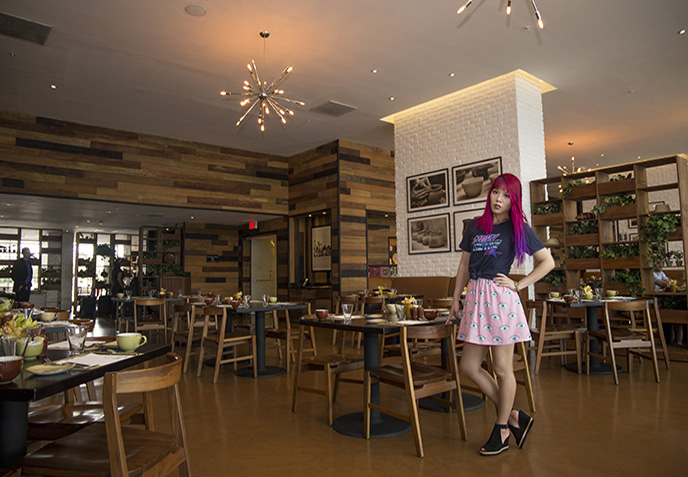
The cozy Manabi Restaurant was decorated with local crafts, and warm wooden furniture. They have an impressive selection of Panamanian rum… but alcohol wasn’t being served because it was Martyr’s Day! (Every year, the city commemorates the 1964 riots over sovereignty of the Panama Canal Zone.)

Nonetheless, I got to enjoy a tropical fruit smoothie with fresh fish ceviche, and Manabi’s hearty seafood dish. I tend to order local fish wherever I go; this time, I got to taste “corvina” (a saltwater fish from the coastal waters of Central and South America) for the first time. I ended with the house-made creme brulee with blueberries — brilliant.

The next day, I was ready to see Panama City. Uber is quite cheap here, so I booked an UberX ride to Casco Viejo (Old Town).

Casco Viejo is located on the waterfront, and has spectacular viewpoints and walkways. Across the water, I spotted the rainbow colored Biomuseo (Museum of Bio-Diversity) designed by Frank Gehry. (If I had an extra day in Panama City, I’d certainly go there.)

30 minutes away, you can visit Miraflores Locks, one of the transit points of the Panama Canal. There’s a history museum about the 77 km (48 mile) waterway, which connects the Atlantic and Pacific Oceans. Visitors can also go to an observation deck to see vessels pass through the Panama Canal.
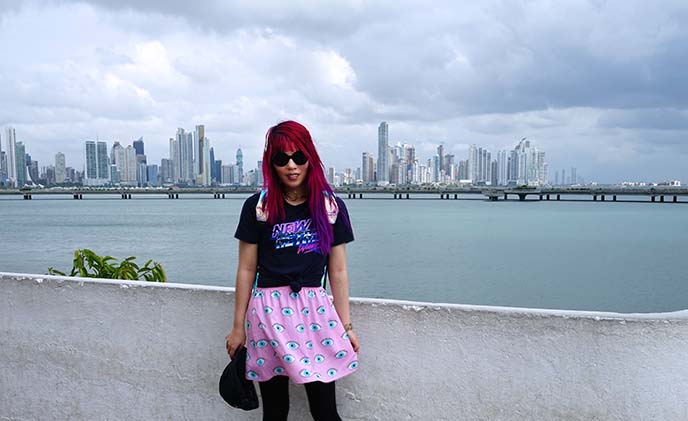
Panama is also known for its long seawalls, which are made for strolling. I looked out at Amador Causeway, the second longest boardwalk in the city and site of museums and restaurants.

I had a limited amount of time so I stuck to Casco Viejo, the historic district of Panama City. This settlement was founded in 1673 after the previous one had been destroyed. Since then, it has survived many natural disasters and attacks by pirates, including the scurvy Captain Henry Morgan.

I passed by the yellow facades of Plaza Bolivar (with a statue of Simon Bolivar in front), and cute sidewalk cafes.

It’s easy to see why Casco Viejo is a UNESCO world heritage site. The old town has beautiful parks, and the classic buildings carries traces of its past (a mix of Spanish, French and American colonial architecture.)

This Panama City neighborhood is also home to the archaeological ruins of the church and convent of Santo Domingo. The structures were built by Dominican Friars shortly after the founding of Casco Viejo, but burnt down in 1756 and were never restored.

I enjoyed seeing the contrast between these historic sites and glitzy, modern Panama (such as this light installation at Sortis Hotel.)
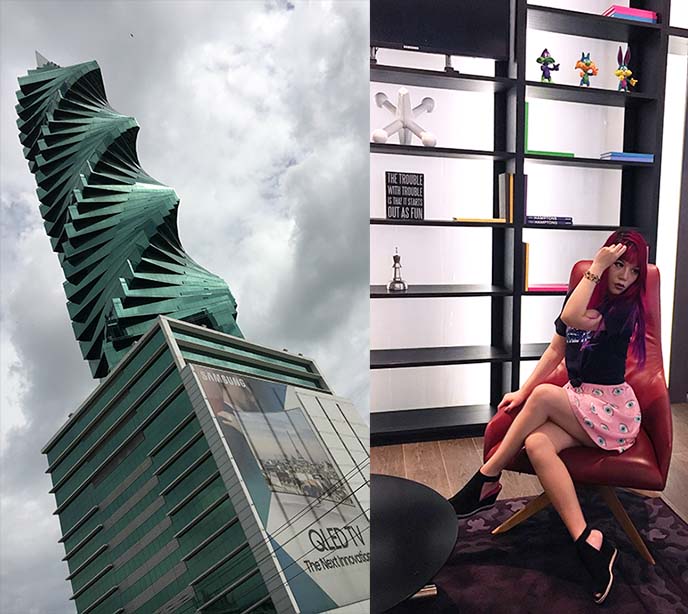
My favorite futuristic building was the F&F Tower, an office building not far from the hotel. I did my best to imitate the twisting green glass and reinforced concrete.

The corkscrew spiral building stands out in the skyline of Panama City.
Whenever the opportunity presents itself for you to experience something new, I say “do it.” You’ll never regret seeing a new destination, and who knows when you might get the chance again.
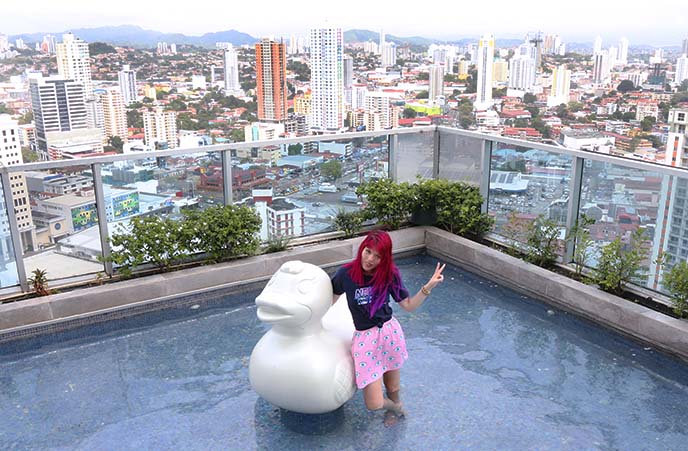
Gracias Sortis Hotel for taking care of me during my layover. My Panama stopover was short but sweet, and makes me keen to come back to do more.
PS: See everyone soon in San Francisco! Follow along @lacarmina Instagram and Facebook to see the fun first-hand.

 LA CARMINA
LA CARMINA






